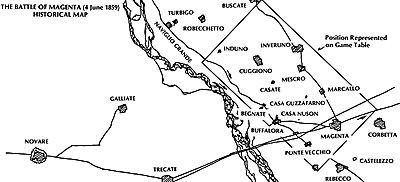 Magenta began with the Grenadier Division of the French Guard Corps, consisting of 3 guard grenadier regiments, each of 3 battalions, the guard zouaves of 2 battalions, and 3 attached rifled batteries seizing Buffalora as a bridgehead over the Grand Canal and Ticino Rivers - a twin water hazard which the Austrians were counting on to preserve their repose.
Magenta began with the Grenadier Division of the French Guard Corps, consisting of 3 guard grenadier regiments, each of 3 battalions, the guard zouaves of 2 battalions, and 3 attached rifled batteries seizing Buffalora as a bridgehead over the Grand Canal and Ticino Rivers - a twin water hazard which the Austrians were counting on to preserve their repose.
Magenta Jumbo Map (Large: slow: 84K)
This occurred against light opposition on the evening of 3 June 1859 over a bridge which survived inept Austrian demolition attempts. The Austrians were camped around Magenta with several corps and a reserve cavalry division (light) in the vicinity. It is not clear that there was anyone effectively in overall command -- they seem to have been waiting for the Emperor to arrive and sort things out. As may be seen from the map, there were many crossing points in the vicinity, but for practical purposes the canal and river could only be crossed at bridges. The French Guard was over at a point near the rail and main road bridges, and was relatively undisturbed in its possession overnight. The Austrians, who had a substantial edge in numbers as well as position, and a strong overall margin in field artillery (although smoothbore against rifles) do not seem to have taken much notice of what appeared to be French patrol actions in the vicinity of Buffalora.
In real life the main French Army, including the Voltigeur division of guards and several corps were on a flank march to the French left, and arrived in two groups by separate roads at different times in the day. For most of the 4th of June the French Grenadier Guards held their positions and kept the Austrians occupied until gradually the pressure built up on the Austrian right flank. When the French, led by the guard Chasseurs a Pied and the 2nd Zouaves took the Magenta railroad station the Austrians grew discouraged and retreated.
For a grand tactical scenario I usually give the French 1-2 small corps (2 divisions each) and 1 large (3 divisions) as well as the grenadier, voltigeur and cavalry divisions of the Guards. They start with the Grenadiers (9 bases) and Zouaves (2 bases) supported by the Chasseurs a Cheval (1 base) and artillery (11 base) dug in over the river. The French player has the option of lining up his remaining forces by corps (except for the guard divisions) to enter by the neighboring bridges, follow the Grenadiers, or come in much later (determined by dice) on flank marches from left or right.
The Austrian players, depending on number, are given command of divisions or brigades in thetwo corps nearest the French-held town. Each corps has two divisions, and one division in each corps has 3 brigades consisting of 4 infantry and 1 jager battalion each; the other has 2 brigades. Each corps also has a base of light cavalry and 3 artillery bases.
At game start, the Austrians are informed that their pickets, driven in during the night, report the enemy in force at Buffalora. It will take one turn to turn out the troops and get them into formation in the vicinity of their encampments.
MAGENTA AS A WARGAME
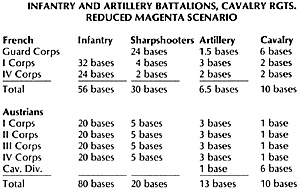 This recount of the battle as fought using the rules "Warfare in the Age of Napoleon the Little" was originally published in PW REVIEW.
This recount of the battle as fought using the rules "Warfare in the Age of Napoleon the Little" was originally published in PW REVIEW.
This game was based loosely on Magenta, 4 June, 1859, at which battle Napoleon III took advantage of Austrian carelessness to slip a Guard Division over the Grand Canal at Buffalora. They held all day as reinforcements poured in, and, late in the day, a strong column arrived by flank march to join an all-out offensive that persuaded the Austrians to quit the road and rail hub of Magenta.
To reconstruct this on a reduced scale, four Austrian corps were deployed around Magenta with a cavalry division in reserve. Only one Austrian corps was placed in touch with the French bridgehead. Dave Ray and Art Hoag were placed in charge of this element and told the general situation, along with the fact that Franz Joseph would be along at some point in the future to take over. See Map 1.
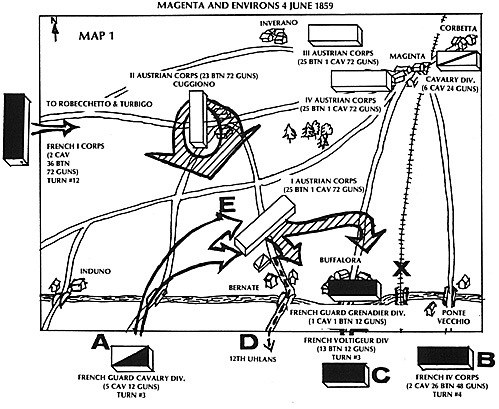 Napoleon III (the Lion himself) (Walter Simon) was given the Grenadier division of the Guard at Buffalora over the canal (point X, mapl) with the Chasseurs a Cheval and 12 guns. Unlike the muddled Austrians, he, ably assisted by Fred Haub, was firmly in charge of the rest of the Guard Corps (the Voltigeur and Cavalry divisions) and the two line corps, the largest of which was on a flank march. The Lion was offered the opportunity to place the remaining corps and the rest of the Guards on any of several bridges, or on the flank march.
Napoleon III (the Lion himself) (Walter Simon) was given the Grenadier division of the Guard at Buffalora over the canal (point X, mapl) with the Chasseurs a Cheval and 12 guns. Unlike the muddled Austrians, he, ably assisted by Fred Haub, was firmly in charge of the rest of the Guard Corps (the Voltigeur and Cavalry divisions) and the two line corps, the largest of which was on a flank march. The Lion was offered the opportunity to place the remaining corps and the rest of the Guards on any of several bridges, or on the flank march.
He opted to put the cavalry over a bridge west of Bernato, and the IV Corps over a bridge (Ponte Vecchio) east of Buffalora. The Voltigeurs, logically enough, followed the Grenadiers into Buffalora. Those elements appeared on the 3rd, 4th, and 5th game turns; the flank marching Ist Corps on the 12th (each being roughly 1/2 hour). See points A, B, and C on Map 1.
Dave and Art reacted with unaccustomed energy for Austrians. They rallied the 25 battalions and 72 guns of the nearest corps and hurled them at Buffalora. This forced the Zouave and Grenadier outposts back on the town. Unfortunately, it is difficult, even with superior numbers, to evict elite riflemen from built up areas occupied overnight. Most of the columns were checked by fire, and the remainder were thrown back by the bayonet. Points A and E on Map 1.
As the battle raged around Buffalora, General Haub led the Guard Cavalry over the canal, and formed up behind the Austrian right rear (Point E). This woke up the next Austrian corps. The 12th Uhlans had already crossed the canal at Bernato to detect the approach of the Voltigeurs. See Point D on Map 1.
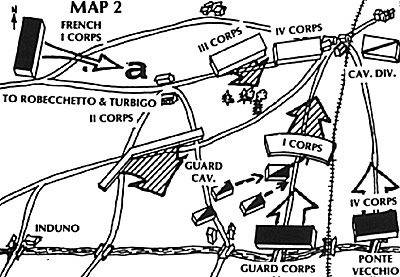 Haub now launched an all-out cavalry attack. The Guides Imperial charged an Austrian artillery battalion in open order, but the guns were able to face them and broke the charge with heavy loss. The Lancers took another battalion in flank, while the 1st and 2nd Cuirassiers and the Empress Dragoons assailed formed Jager battalions. only the 2nd Cuirassiers succeeded in this endeavor. Repulsed units fell back on the horse artillery while the others swirled around with the mass of routed and rallying Austrians near Buffalora. Those in order shrugged off attacks;
those in disorder were cut off or cut down, but more guns were overrun and the Guard infantry and Chasseurs a Cheval broke out of town to press the attack.
Haub now launched an all-out cavalry attack. The Guides Imperial charged an Austrian artillery battalion in open order, but the guns were able to face them and broke the charge with heavy loss. The Lancers took another battalion in flank, while the 1st and 2nd Cuirassiers and the Empress Dragoons assailed formed Jager battalions. only the 2nd Cuirassiers succeeded in this endeavor. Repulsed units fell back on the horse artillery while the others swirled around with the mass of routed and rallying Austrians near Buffalora. Those in order shrugged off attacks;
those in disorder were cut off or cut down, but more guns were overrun and the Guard infantry and Chasseurs a Cheval broke out of town to press the attack.
Somewhere along the line Ray and Haub asked about reinforcements. That was the trick play. To get more Austrians you must first notify them that something is going on. It was in a sense unfair not to tell the Austrians this, however, it seemed the best way to duplicate the actual Austrian command problems at Magenta.
Once alerted, the whole white coated mass lurched into action and began to swarm in on the erupting French forces. This had the effect of putting the rear of the western-most corps to the advancing French 1st Corps. See Point A on Map 2.
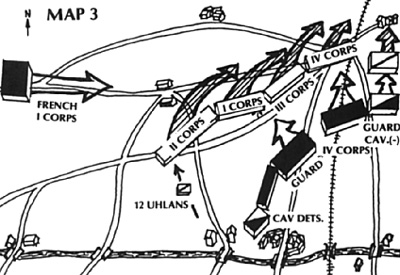 However, the returning 12th Uhlans noticed the dust clouds and alerted the Austrian Corps commanders. This led Simon to make what seemed to be a tactical error... pushing the French IV Corps, guns and all, up close to the Austrian lines and sacrificing their range advantage. See Point A on Map 3.
However, the returning 12th Uhlans noticed the dust clouds and alerted the Austrian Corps commanders. This led Simon to make what seemed to be a tactical error... pushing the French IV Corps, guns and all, up close to the Austrian lines and sacrificing their range advantage. See Point A on Map 3.
Simon later explained that his intention was to keep the Austrians from withdrawing troops to face the 1st Corps. At any rate, he did not pay for this bit of bravado- once the reformed Guard Cavalry had shrugged off an attack by the Austrian Light Cavalry Division, and the I Corps guns went into action on the other flank, the disgusted Austrian commanders, shaken by a long series of minor tactical reverses, abandoned their hold on Magenta.
More Scenarios for 1859
Back to Table of Contents -- Courier Vol. VII #5
To Courier List of Issues
To MagWeb Master Magazine List
© Copyright 1987 by The Courier Publishing Company.
This article appears in MagWeb (Magazine Web) on the Internet World Wide Web.
Other military history articles and gaming articles are available at http://www.magweb.com